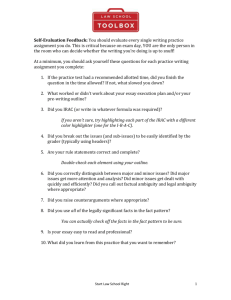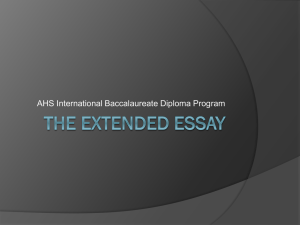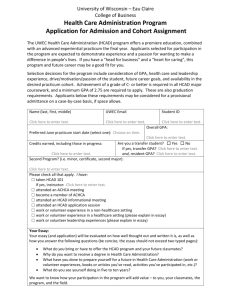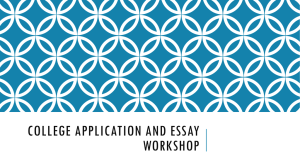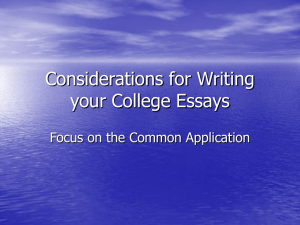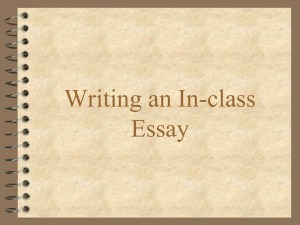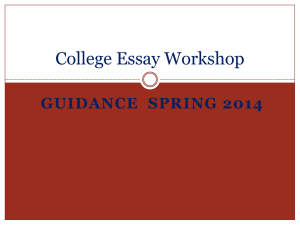7-Robin Boyle Laisur.. - Law School Academic Success Project
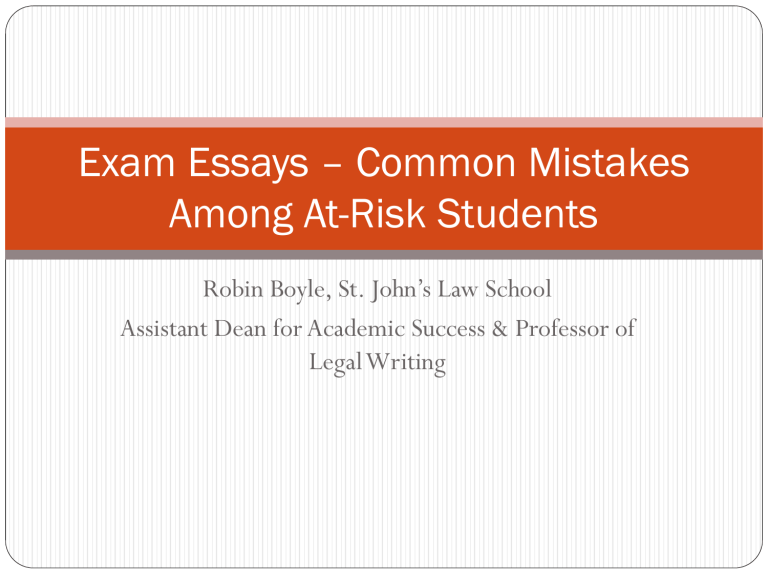
Exam Essays – Common Mistakes
Among At-Risk Students
Robin Boyle, St. John’s Law School
Assistant Dean for Academic Success & Professor of
Legal Writing
October 22, 2011
LSAC Academic Assistance Topical Workshop
“Finding a Way Through: Working With Students Who Have
Learning Disabilities”
My experience:
Teaching LRW for 18 years
Directing ASP for 6 years
Contracts I (Conditional Admissions Program) for 4 years
Legal Analysis Practicum (At-Risk 1L) 1 year
Agency Practicum (At-Risk 2L) in progress
Why Focus on At-Risk Populations?
Prevalence of learning disabled students (although not all LD students are on the lower end of GPA range).*
Not all at- risk students have diagnoses.
Not all students with diagnoses inform me.
Even if I’m informed, not all LD present the same way on exams.
* See Leah Christensen, Legal Reading and Success in Law School:
The Reading Strategies of Law Students with ADD, 12 The
Scholar: St. Mary’s L. Rev. on Minority Issues 173 (2010).
About the LAP (1L course)
36 students enrolled in total:
17 students below 2.1 (Academic Probation) – mandatory enrollment
10 students b/w 2.1 & 2.2 (Required to receive AS services)
– mandatory enrollment
Offered to @ 30 students whose GPA were b/w 2.2 and
2.49 – of those students, 9 opted in
In 1
st
year/2
nd
semester LAP course
Predominant problems
Not providing enough text
Going off on tangents – stream of consciousness
Haven’t mastered IRAC (“I didn’t get it 1 st semester”)
Need more careful case reading & statutory reading
Strategies to Remedy
Provided weekly writing assignments
Focused on IRAC
Explained different purposes (not just exams –
“If a memo, then . . . If a brief, then . . . ”)
Course topics
Close Case & Statutory Reading
Outlining
Rule Synthesis
Application of Law to Fact – Analogy/Distinction
Essay Exam Writing
Learning Styles*
See Robin A. Boyle, Law Students With ADD: How to Reach Them,
How to Teach Them, 39 John Marshall L. Rev. 349 (2006)
Emphasis
Organization of Legal Analysis:
Intro (thesis paras)
Divide by sub-issues
Rules – with and without statutes, synthesis of case holdings
Application to facts with detail (not skipping steps)
Stating counterarguments
Stating conclusions without ambiguity
Writing Assignment Topics
Assignment #1 Common law:
Contracts case: Sidway v. Hamer – (uncle who promised nephew not to drink/gamble until age 21 - $) produce case brief, summarize for a course outline, write essay on hypothetical fact pattern.
Statutory Analysis
Assignment #2
New York Vehicle & Traffic Law –
Definition of Motor Vehicle in Sec. 125 (vehicle propelled by any power other than muscular power, then exceptions . . .)
Two fact questions – how would the court decide (actual cases)?
In each question – was there a “motor vehicle”?
Practice Separating by Issue
Assignment #3 -
Restatement 2d Sec. 90 (Promise Reasonably Inducing
Action or Forbearance)
1) A promise which the promisor should reasonably expect to induce action . . .
2) on part of the promisee . . .
3) does induce such action . . .
4) is binding if injustice can be avoided
Two hypo fact patterns given – essay answers required
Rule Synthesis
Assignment #4
Covenant not to Compete – two fictitious cases and a fact pattern
Goal was to divide by sub-issues
Synthesize rules
Apply in detail
More Rule Synthesis
Assignment #5
Topic: Emotional Distress
Restatement 2d of Torts
4 Summaries of cases
Hypothetical facts
Goal: Write an essay using IRAC
Course Materials
Distributed Succeeding in Law School, by Herb Ramy
Handouts
Results of First Year LAP course
Students who attended class and turned in assignments showed improvement in their Spring GPAs to a statistical significance level in comparison to those in their GPA cohort who did not participate.
Suggestions – try to get buy-in from students (relevant topics, offer course credit, offer course grade)
Improvements seen from 1L to 2L
More text in their essay answers.
Some students are using good organization to essays.
Some students are reading cases and Restatement very well.
Some 1Ls improved GPAs and are not required in 2L course.
Agency Practicum
Course text: J. Dennis Hynes & Mark J. Loewenstein,
AGENCY, PARTNERSHIP, AND THE LLC (Abridged 7 th ed.
Lexis Nexis).
Two sections – 9 in Day
9 in evening
Most of the students are required to take course (GPA’s under 2.2).
Agency Practicum (2L’s)
Common Problems with essays and exam answers
Issue statements lack legal terms
Rushes past the rule (reduced to bullet outline, parenthetical)
Doesn’t delve into the next level of rule (repeats the general rule)
Lacks meaningful application of law to fact
Brushes past counterargts
Mentions cases that were not covered in class
HW for Agency 2Ls
Writing short essays to hypothetical problems
Submitting course outline of first two chapters (I spotted over-inclusive and under-inclusive outlining)
Drafting contract provisions from the point of view of 3 different parties
Self-Assessment survey (what percentage of time last semester did you spend on briefing cases? What did you learn from meeting with your professors about exam-taking skills?)
In-class work
Provided an open-book mid-term
Reviewed in class the exam & assigned re-write as HW
Because it was doctrinal course, spent more class time discussing cases than in LAP course (1 st year).
Small class size allowed for students to spend time on their questions about assigned readings and other topics
Integrating ASP skills
Learning styles assessments (online Building Excellence)
Time Management
Test Anxiety discussed
Individualized feedback – electronic commenting
One-on-one conferences
Any Questions -
Contact – boyler@stjohns.edu
(718) 990-6609
Thank you!!
